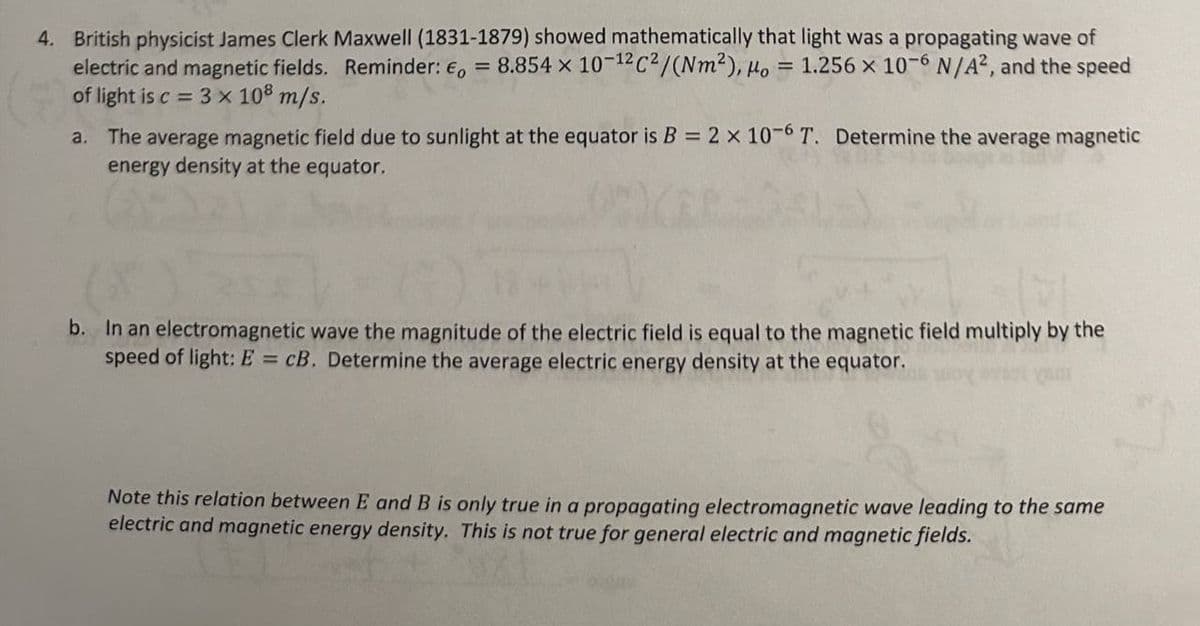4. British physicist James Clerk Maxwell (1831-1879) showed mathematically that light was a propagating wave of electric and magnetic fields. Reminder: €, = 8.854 x 10-¹2 C²/(Nm²), Ho = 1.256 x 10-6 N/A², and the speed of light is c = 3 x 108 m/s. a. The average magnetic field due to sunlight at the equator is B = 2 x 10-6 T. Determine the average magnetic energy density at the equator. (*) b. In an electromagnetic wave the magnitude of the electric field is equal to the magnetic field multiply by the speed of light: E = CB. Determine the average electric energy density at the equator.
4. British physicist James Clerk Maxwell (1831-1879) showed mathematically that light was a propagating wave of electric and magnetic fields. Reminder: €, = 8.854 x 10-¹2 C²/(Nm²), Ho = 1.256 x 10-6 N/A², and the speed of light is c = 3 x 108 m/s. a. The average magnetic field due to sunlight at the equator is B = 2 x 10-6 T. Determine the average magnetic energy density at the equator. (*) b. In an electromagnetic wave the magnitude of the electric field is equal to the magnetic field multiply by the speed of light: E = CB. Determine the average electric energy density at the equator.
Principles of Physics: A Calculus-Based Text
5th Edition
ISBN:9781133104261
Author:Raymond A. Serway, John W. Jewett
Publisher:Raymond A. Serway, John W. Jewett
Chapter24: Electromagnetic Waves
Section: Chapter Questions
Problem 74P
Related questions
Question

Transcribed Image Text:4. British physicist James Clerk Maxwell (1831-1879) showed mathematically that light was a propagating wave of
electric and magnetic fields. Reminder: €, = 8.854 x 10-12 C²/(Nm²), Mo = 1.256 x 10-6 N/A², and the speed
of light is c = 3 x 108 m/s.
a. The average magnetic field due to sunlight at the equator is B = 2 x 10-6 T. Determine the average magnetic
energy density at the equator.
b. In an electromagnetic wave the magnitude of the electric field is equal to the magnetic field multiply by the
speed of light: E = CB. Determine the average electric energy density at the equator.
Note this relation between E and B is only true in a propagating electromagnetic wave leading to the same
electric and magnetic energy density. This is not true for general electric and magnetic fields.
Expert Solution
This question has been solved!
Explore an expertly crafted, step-by-step solution for a thorough understanding of key concepts.
Step by step
Solved in 4 steps with 5 images

Knowledge Booster
Learn more about
Need a deep-dive on the concept behind this application? Look no further. Learn more about this topic, physics and related others by exploring similar questions and additional content below.Recommended textbooks for you

Principles of Physics: A Calculus-Based Text
Physics
ISBN:
9781133104261
Author:
Raymond A. Serway, John W. Jewett
Publisher:
Cengage Learning

Physics for Scientists and Engineers
Physics
ISBN:
9781337553278
Author:
Raymond A. Serway, John W. Jewett
Publisher:
Cengage Learning

Physics for Scientists and Engineers with Modern …
Physics
ISBN:
9781337553292
Author:
Raymond A. Serway, John W. Jewett
Publisher:
Cengage Learning

Principles of Physics: A Calculus-Based Text
Physics
ISBN:
9781133104261
Author:
Raymond A. Serway, John W. Jewett
Publisher:
Cengage Learning

Physics for Scientists and Engineers
Physics
ISBN:
9781337553278
Author:
Raymond A. Serway, John W. Jewett
Publisher:
Cengage Learning

Physics for Scientists and Engineers with Modern …
Physics
ISBN:
9781337553292
Author:
Raymond A. Serway, John W. Jewett
Publisher:
Cengage Learning

College Physics
Physics
ISBN:
9781938168000
Author:
Paul Peter Urone, Roger Hinrichs
Publisher:
OpenStax College
